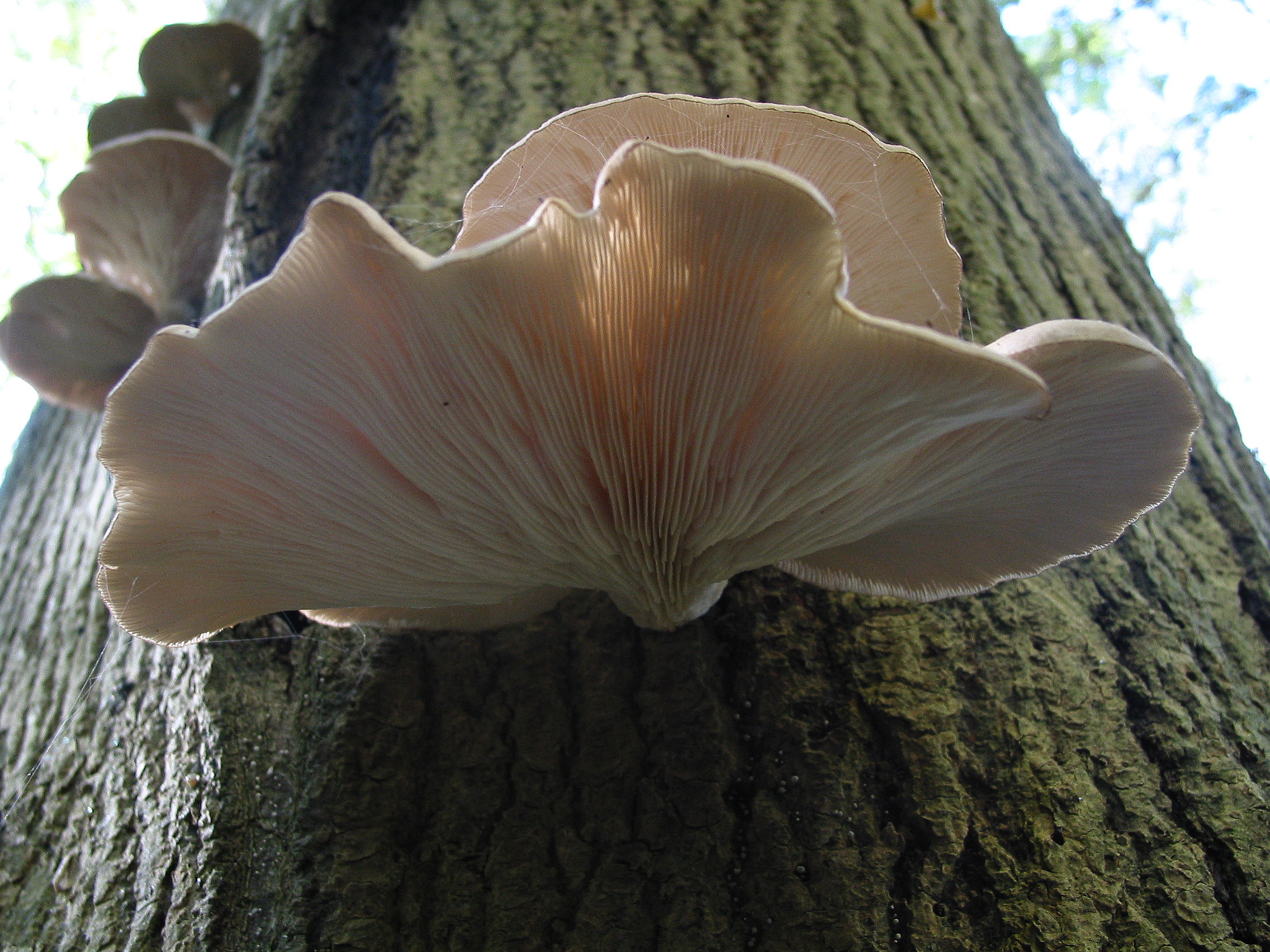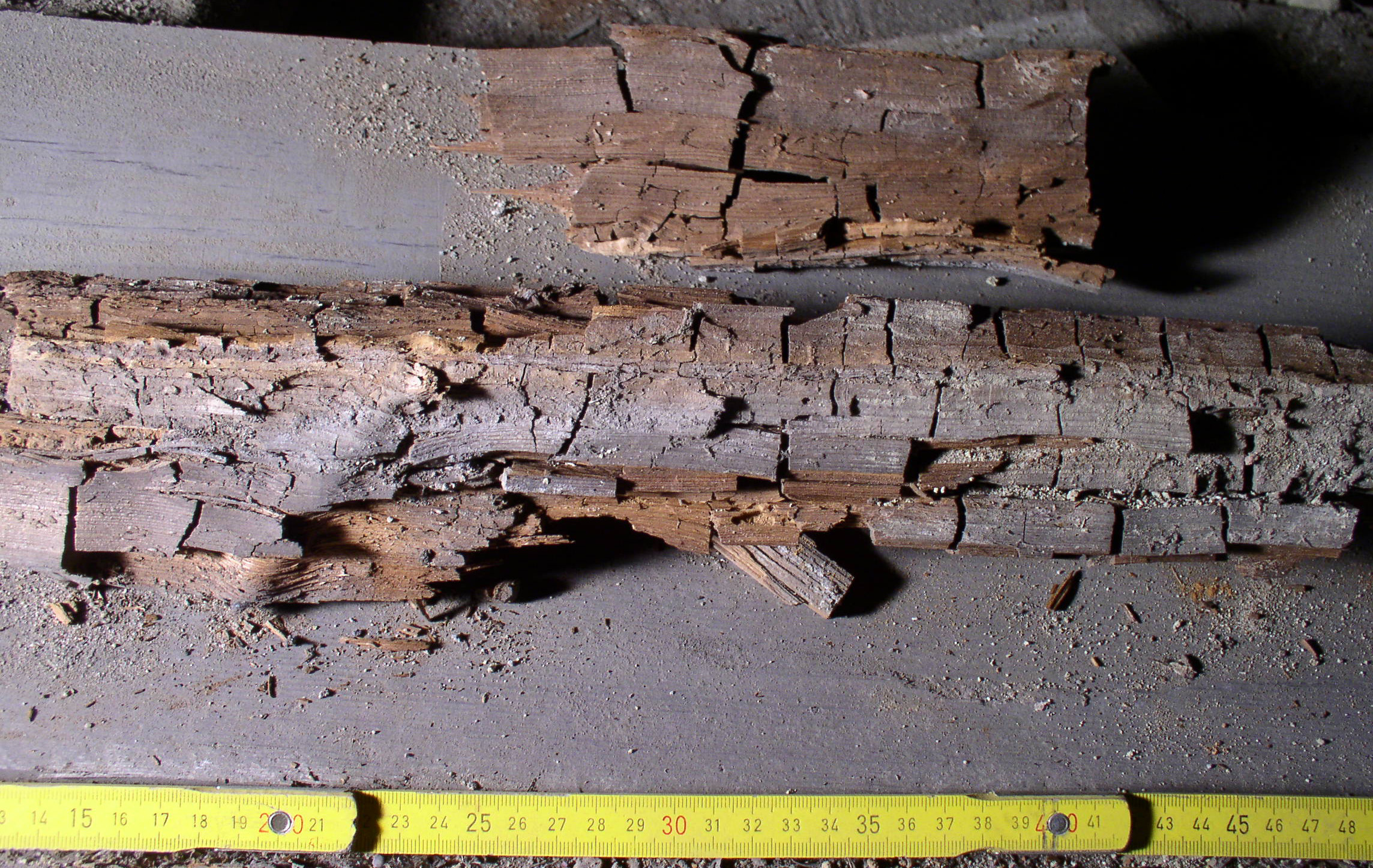|
Pleurotus Ostreatus
''Pleurotus ostreatus'', the oyster mushroom, oyster fungus, or hiratake, is a common edible mushroom. It was first cultivated in Germany as a subsistence measure during World War I and is now grown commercially around the world for food. It is related to the similarly cultivated king oyster mushroom. Oyster mushrooms can also be used industrially for mycoremediation purposes. The oyster mushroom is one of the more commonly sought wild mushrooms, though it can also be cultivated on straw and other media. It has the bittersweet aroma of benzaldehyde (which is also characteristic of bitter almonds). Name Both the Latin and common names refer to the shape of the fruiting body. The Latin ''pleurotus'' (side-ear) refers to the sideways growth of the stem with respect to the cap, while the Latin ''ostreatus'' (and the English common name, oyster) refers to the shape of the cap which resembles the bivalve of the same name. The reference to ''oyster'' may also derive from the slippe ... [...More Info...] [...Related Items...] OR: [Wikipedia] [Google] [Baidu] |
Mycoremediation
Mycoremediation (from ancient Greek ''μύκης (mukēs)'', meaning "fungus" and the suffix ''-remedium'', in Latin meaning 'restoring balance') is a form of bioremediation in which fungi-based remediation methods are used to decontaminate the environment. Fungi have been proven to be a cheap, effective and environmentally sound way for removing a wide array of contaminants from damaged environments or wastewater. These contaminants include heavy metals, organic pollutants, textile dyes, leather tanning chemicals and wastewater, petroleum fuels, polycyclic aromatic hydrocarbons, pharmaceuticals and personal care products, pesticides and herbicides in land, fresh water, and marine environments. The byproducts of the remediation can be valuable materials themselves, such as enzymes (like laccase), edible or medicinal mushrooms, making the remediation process even more profitable. Some fungi are useful in the biodegradation of contaminants in extremely cold or radioactive environment ... [...More Info...] [...Related Items...] OR: [Wikipedia] [Google] [Baidu] |
Nikolaus Joseph Von Jacquin
Nikolaus Joseph Freiherr von Jacquin (16 February 172726 October 1817) was a scientist who studied medicine, chemistry and botany. Biography Born in Leiden in the Netherlands, he studied medicine at Leiden University, then moved first to Paris and afterward to Vienna. In 1752, he studied under Gerard van Swieten in Vienna. Between 1755 and 1759, Jacquin was sent to the West Indies, Central America, Venezuela and New Granada by Francis I to collect plants for the Schönbrunn Palace, and amassed a large collection of animal, plant and mineral samples. In 1797, Alexander von Humboldt profited from studying these collections and conversing with Jacquin in preparation of his own journey to the Americas. In 1763, Jacquin became professor of chemistry and mineralogy at the Bergakademie Schemnitz (now Banská Štiavnica in Slovakia). In 1768, he was appointed Professor of Botany and Chemistry and became director of the botanical gardens of the University of Vienna. For his work ... [...More Info...] [...Related Items...] OR: [Wikipedia] [Google] [Baidu] |
Carnivorous Fungus
Carnivorous fungi or predaceous fungi are fungi that derive some or most of their nutrients from trapping and eating microscopic or other minute animals. More than 200 species have been described, belonging to the phyla Ascomycota, Mucoromycotina, and Basidiomycota. They usually live in soil and many species trap or stun nematodes (nematophagous fungus), while others attack amoebae or collembola. Fungi that grow on the epidermis, hair, skin, nails, scales or feathers of living or dead animals are considered to be dermatophytes rather than carnivores. Similarly, fungi in orifices and the digestive tract of animals are not carnivorous, and neither are internal pathogens. Neither are insect pathogens that stun and colonize insects normally labelled carnivorous if the fungal thallus is mainly in the insect as does ''Cordyceps'', or if it clings to the insect like the Laboulbeniales. All of these are examples of parasitism or scavenging. Two basic trapping mechanisms have been obs ... [...More Info...] [...Related Items...] OR: [Wikipedia] [Google] [Baidu] |
Wood-decay Fungus
A wood-decay or xylophagous fungus is any species of fungus that digests moist wood, causing it to rot. Some species of wood-decay fungi attack dead wood, such as brown rot, and some, such as '' Armillaria'' (honey fungus), are parasitic and colonize living trees. Excessive moisture above the fibre saturation point in wood is required for fungal colonization and proliferation. In nature, this process causes the breakdown of complex molecules and leads to the return of nutrients to the soil. Wood-decay fungi consume wood in various ways; for example, some attack the carbohydrates in wood and some others decay lignin. The rate of decay of wooden materials in various climates can be estimated by empirical models.Viitanen, T. et al. (2010). Towards modelling of decay risk of wooden materials. European Journal of Wood and Wood Products 68:303-313. Wood-decay fungi can be classified according to the type of decay that they cause. The best-known types are brown rot, soft rot, and wh ... [...More Info...] [...Related Items...] OR: [Wikipedia] [Google] [Baidu] |
Saprotroph
Saprotrophic nutrition or lysotrophic nutrition is a process of chemoheterotrophic extracellular digestion involved in the processing of decayed (dead or waste) organic matter. It occurs in saprotrophs, and is most often associated with fungi (for example ''Mucor'') and soil bacteria. Saprotrophic microscopic fungi are sometimes called saprobes; saprotrophic plants or bacterial flora are called saprophytes ( sapro- 'rotten material' + -phyte 'plant'), although it is now believed that all plants previously thought to be saprotrophic are in fact parasites of microscopic fungi or other plants. The process is most often facilitated through the active transport of such materials through endocytosis within the internal mycelium and its constituent hyphae. states the purpose of saprotrophs and their internal nutrition, as well as the main two types of fungi that are most often referred to, as well as describes, visually, the process of saprotrophic nutrition through a diagram of hyph ... [...More Info...] [...Related Items...] OR: [Wikipedia] [Google] [Baidu] |
Pleurotus Populinus
''Pleurotus populinus'', the aspen oyster mushroom, is a gilled fungus native to North America. It is found on dead wood of aspen and cottonwood trees (genus ''Populus''). Although morphologically similar to ''Pleurotus ostreatus'' and '' Pleurotus pulmonarius'', it has been shown to be a distinct species incapable of cross-breeding. ''P. populinus'' is reported to be edible. Unlike ''P. ostreatus'', which fruits in the autumn and winter, ''P. populinus'' fruits in late spring and summer. Taxonomy The species was first described scientifically by mycologists Oswald and Orson K. Miller in 1993 with a provisional name. This original naming was invalid according to several sections of the International Code of Botanical Nomenclature, so it was republished in 1997. Description The fruit bodies have oyster shell-shaped to fan-shaped caps that are broad by wide. The cap margin is initially rolled inward, becomes finely scalloped in age. The color ranges from iv ... [...More Info...] [...Related Items...] OR: [Wikipedia] [Google] [Baidu] |
Pleurotus Pulmonarius
''Pleurotus pulmonarius'', commonly known as the Indian oyster, Italian oyster, phoenix mushroom, or the lung oyster, is a mushroom very similar to ''Pleurotus ostreatus'', the pearl oyster, but with a few noticeable differences. The caps of ''pulmonarius'' are much paler and smaller than ''ostreatus'' and develops more of a stem. ''P. pulmonarius'' also prefers warmer weather than ''ostreatus'' and will appear later in the summer. Otherwise, the taste and cultivation of the two species is generally described as largely the same. Another similar species, North America's ''Pleurotus populinus'', is restricted to growing on aspen and cottonwood. Natural habitat ''Pleurotus pulmonarius'' is widespread in temperate and subtropical forests throughout the world. In the eastern United States, this species is generally found on hardwoods while in the west it is commonly found on conifers. Taxonomy *1821 First published as ''Agaricus pulmonarius'' by Fr. *1975 Disambiguated from ''Pleur ... [...More Info...] [...Related Items...] OR: [Wikipedia] [Google] [Baidu] |
North America
North America is a continent in the Northern Hemisphere and almost entirely within the Western Hemisphere. It is bordered to the north by the Arctic Ocean, to the east by the Atlantic Ocean, to the southeast by South America and the Caribbean Sea, and to the west and south by the Pacific Ocean. Because it is on the North American Plate, North American Tectonic Plate, Greenland is included as a part of North America geographically. North America covers an area of about , about 16.5% of Earth's land area and about 4.8% of its total surface. North America is the third-largest continent by area, following Asia and Africa, and the list of continents and continental subregions by population, fourth by population after Asia, Africa, and Europe. In 2013, its population was estimated at nearly 579 million people in List of sovereign states and dependent territories in North America, 23 independent states, or about 7.5% of the world's population. In Americas (terminology)#Human ge ... [...More Info...] [...Related Items...] OR: [Wikipedia] [Google] [Baidu] |
Pacific Northwest
The Pacific Northwest (sometimes Cascadia, or simply abbreviated as PNW) is a geographic region in western North America bounded by its coastal waters of the Pacific Ocean to the west and, loosely, by the Rocky Mountains to the east. Though no official boundary exists, the most common conception includes the U.S. states of Oregon, Washington (state), Washington, and Idaho, and the Canadian province of British Columbia. Some broader conceptions reach north into Alaska and Yukon, south into northern California, and east into western Montana. Other conceptions may be limited to the coastal areas west of the Cascade Mountains, Cascade and Coast Mountains, Coast mountains. The variety of definitions can be attributed to partially overlapping commonalities of the region's history, culture, geography, society, ecosystems, and other factors. The Northwest Coast is the coastal region of the Pacific Northwest, and the Northwest Plateau (also commonly known as "British Columbia Interi ... [...More Info...] [...Related Items...] OR: [Wikipedia] [Google] [Baidu] |
Pleurotus Ostreatus JPG6
''Pleurotus'' is a genus of gilled mushrooms which includes one of the most widely eaten mushrooms, '' P. ostreatus''. Species of ''Pleurotus'' may be called oyster, abalone, or tree mushrooms, and are some of the most commonly cultivated edible mushrooms in the world. ''Pleurotus'' fungi have also been used in mycoremediation of pollutants, such as petroleum and polycyclic aromatic hydrocarbons. Etymology The genus name ''Pleurotus'' literally means ''side ear'' in reference to the mushroom caps being laterally attached to the substrate. It is a composite of the Ancient Greek words : pleurá - ''side'', and the stem ''-oto'' referring to ears (from , ὠτός : ''ear''). Description The caps may be laterally attached (with no stipe). If there is a stipe, it is normally eccentric and the gills are decurrent along it. The term ''pleurotoid'' is used for any mushroom with this general shape. The spores are smooth and elongated (described as "cylindrical"). Where hyphae meet, ... [...More Info...] [...Related Items...] OR: [Wikipedia] [Google] [Baidu] |
Protein (nutrient)
Proteins are essential nutrients for the human body. They are one of the building blocks of body tissue and can also serve as a fuel source. As a fuel, proteins provide as much energy density as carbohydrates: 4 kcal (17 kJ) per gram; in contrast, lipids provide 9 kcal (37 kJ) per gram. The most important aspect and defining characteristic of protein from a nutritional standpoint is its amino acid composition. Proteins are polymer chains made of amino acids linked together by peptide bonds. During human digestion, proteins are broken down in the stomach to smaller polypeptide chains via hydrochloric acid and protease actions. This is crucial for the absorption of the essential amino acids that cannot be biosynthesized by the body. There are nine essential amino acids which humans must obtain from their diet in order to prevent protein–energy malnutrition and resulting death. They are phenylalanine, valine, threonine, tryptophan, methionine, leucine, isole ... [...More Info...] [...Related Items...] OR: [Wikipedia] [Google] [Baidu] |



.jpg)
